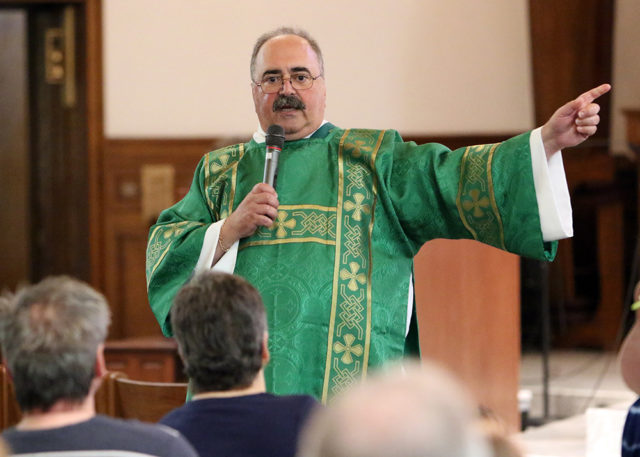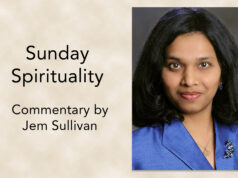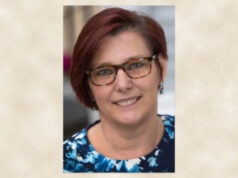
There is very little that a priest does each week that requires so much attention as the Sunday homily. The homily can be a source of inspiration or it can be a stumbling block for many in the assembly. For the one who prepares and delivers it, it may be a unique opportunity for strengthening the call to discipleship.
Like the proverbial person looking at a painting in the museum, people often don’t know a lot about homilies, but they know what they like. What they like can vary, thus causing even more challenge to the homilist. As a priest I have discovered both the preparation and the delivery of each homily have to be taken seriously.
Every Tuesday morning I lead a Bible study group right after the morning Mass. These days about 30 or 35 people show up. We read through the readings of the upcoming Sunday and then discuss both the background of these readings and their message for us today. This becomes the beginning of my weekly homily preparation.
Starting my homily work with a group of faithful laity helps me go beyond the textbook analysis of a passage. Members of the group readily find application for each Scripture passage. I appreciate this bottom-up homily building. Furthermore, the very purpose of a homily becomes clear, namely, to help articulate the message of the Scriptures for today’s world.
These sessions emphasize that a homily is to be a bridge, a bridge between the message of the Scriptures and their meaning in the 21st century. It’s not that the words of Jesus change, but the way they need to be translated into everyday life always has to be renewed.
One of the finest compliments that can be given for a homily is that the preacher helps the hearer deal with current issues in his or her life in the light of the Gospel. Often there is the component of hope even when the readings challenge people to overcome dark forces in their lives.
After the Bible study group has given feedback and shared their thoughts on the readings, there are other opportunities each Tuesday to read the readings aloud, specifically at Tuesday evening Rite of Christian Initiation of Adults and during the recording of our weekly podcast. Each time the reading of the passages opens up the central theme a little bit more.
Then comes Wednesday! I call it my day off, and it is a day for hiking (or cross-country skiing, depending on the season), working in the garden or inside the house, and reading. I always keep a notebook nearby. Most of the time prayerful free-floating thoughts allow me to find the right focus for each week’s homily. By Wednesday night I know where I am heading.
Both Thursday and Friday mornings are times for detailed outlines of the homily. I may be sitting at the local coffee shop where many people come and go, but for me it is a time to put my thoughts, along with examples and images, into an order that may make sense.
The homily, I have learned, has to provide imagery. Sometimes I feel like I am painting verbal pictures; sometimes a small anecdote does the job. Stories can be very helpful, but I rarely use canned stories. Rather, many of my examples come from the many little events recorded in the journals I have kept over the years.
In the midst of all this, I also try out some of my examples on other people, including staff members. Once in a while I will tell a brief story to someone I trust, asking if it conveys the message I want. And while driving alone, I will recite parts of the homily aloud to see if I can say it as I wish.
Finally, late on Friday or early on Saturday I put the entire homily, word for word, into the computer. I type as fast as I can, causing me to look for transitions and coherence of message. It often amazes me how some of my best ideas from the outline no longer fit when I write it out. And some very good stories have ended up on the cutting room floor!
By the time weekend Mass arrives, I no longer need notes. In fact, I can stay true to what I have written, guarding myself against any unhelpful tangents.
Even here, however, the homily partnership with the listeners is not over. Since I often have the Saturday evening Mass, I get feedback from others. Since we stream all of our Masses through the parish website, I may watch and critique myself after the evening Mass. There have been some helpful changes made between Saturday evening and Sunday morning.
The Sunday homily does not end on Sunday, however. Through our parish disciple groups and the discussion questions that I prepare for their weekly meetings, the word of God remains a significant part of people’s lives throughout the subsequent week.
Just as people have reviewed the Gospel passage before coming to Mass, they also continue to internalize it throughout the week. My homily is only a part of the total picture.
— By Father Herb Weber, Catholic News Service
(Father Herb Weber is founding pastor of St. John XXIII Catholic Church, Perrysburg, Ohio. His weekly podcast as well as the homily replay can be found at 23.church.)









